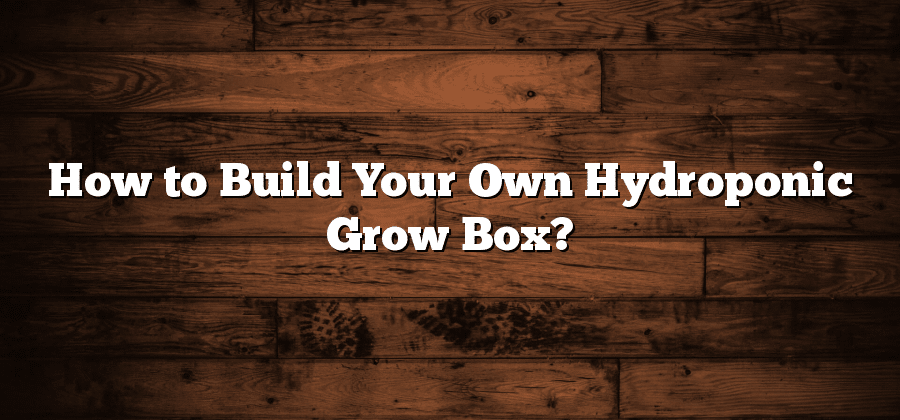Understanding the Basics of Hydroponics
Hydroponics, a method of growing plants without soil, has gained popularity in recent years. This innovative technique involves providing plants with all the necessary nutrients through a water-based solution. By eliminating the need for soil, hydroponics offers several advantages such as increased plant growth, improved nutrient uptake, and better disease control.
One of the key principles behind hydroponics is the ability to control and optimize the growing environment. With traditional soil-based gardening, plants must adapt to the conditions set by nature. However, hydroponics allows growers to tailor the environment to suit the specific needs of the plants. Variables such as temperature, humidity, pH levels, and nutrient concentrations can be closely monitored and adjusted accordingly. This level of control enables superior plant growth and the ability to grow crops in areas with unfavourable soil conditions or limited space.
Selecting the Right Materials for Your Grow Box
When it comes to selecting the right materials for your grow box, there are several factors to consider. First and foremost, you want materials that are strong and durable, able to withstand the constant exposure to moisture and various nutrient solutions. Look for materials such as high-quality plastic or reinforced glass that can resist water damage and provide a stable environment for your plants to thrive.
In addition to durability, you also want to prioritize materials that are non-toxic and safe for your plants. Avoid using materials that may leach harmful chemicals into the nutrient solutions or affect the overall health of your plants. It’s always a good idea to do thorough research and consult with experts to ensure the materials you choose are plant-friendly and won’t compromise the success of your hydroponic system. Remember, investing in the right materials upfront will save you time, money, and potential headaches down the road.
Designing an Efficient and Functional Hydroponic System
Hydroponics is a method of growing plants without soil, where nutrients are provided through water instead. Designing an efficient and functional hydroponic system is crucial for maximizing plant growth and achieving optimal yields. There are several key factors to consider when designing such a system.
Firstly, the choice of hydroponic system plays a vital role in its efficiency. There are various types to choose from, including deep water culture, nutrient film technique, and aeroponics, each with its own benefits and drawbacks. Assessing the specific requirements of your plants and the space available will help determine the most suitable system for your needs.
Furthermore, nutrient delivery is an essential aspect of a functional hydroponic system. Ensuring that the right balance of nutrients is provided to the plants at the right time is crucial for healthy growth. This requires careful monitoring and adjusting of nutrient levels to prevent deficiencies or toxicities. Additionally, water quality is equally important, as poor water quality can hinder nutrient absorption and lead to plant stress. Therefore, investing in a reliable filtration system is recommended to maintain the health and vitality of your hydroponic system.
In conclusion, designing an efficient and functional hydroponic system involves careful consideration of the hydroponic system type and nutrient delivery. Additionally, attention to water quality is critical for ensuring optimal plant growth. By taking these factors into account, you can create a hydroponic system that maximizes yields and produces healthy, thriving plants.
Building the Frame and Structure of Your Grow Box
When constructing your own hydroponic grow box, the frame and structure are crucial elements to consider. The frame provides support for the entire system and ensures stability, while the structure houses all the components necessary for your plants to thrive.
Choosing the right materials for building your grow box is essential. Opt for materials that are sturdy, durable, and can withstand the weight of the system. Common options include wood or metal frames, as they offer excellent stability. Additionally, consider the size and layout of your grow box to determine the appropriate dimensions for your frame. These factors will help create a solid foundation for your hydroponic system, allowing it to function efficiently.
Installing Lighting Systems for Optimal Plant Growth
A key factor in ensuring optimal plant growth in a hydroponic system is the installation of lighting systems. Plants rely on light to carry out photosynthesis, a process that converts light energy into chemical energy, crucial for growth and development. When selecting lighting systems for your hydroponic setup, it is important to consider the specific requirements of the plants you are growing. Different plants have varying light intensity and duration needs, so it is essential to choose the right type and intensity of lights for optimal growth.
LED lights have gained popularity among hydroponic growers due to their energy efficiency and ability to provide the necessary light spectrum for plant growth. LED lights emit specific wavelengths of light that are easily absorbed by plants, allowing for optimal photosynthesis. Additionally, LED lights produce less heat compared to other lighting options, reducing the risk of plant damage caused by overheating. When installing LED lights, ensuring proper positioning and distance from the plants is crucial for achieving uniform light distribution throughout the growth area. This can be achieved by using adjustable mounting systems and optimizing the height and angles of the light fixtures. By carefully considering the lighting needs of your plants and selecting the appropriate lighting systems, you can provide optimal conditions for their growth and maximize your hydroponic yield.






